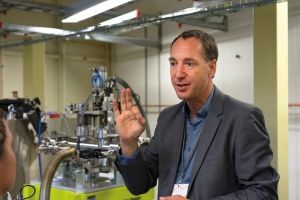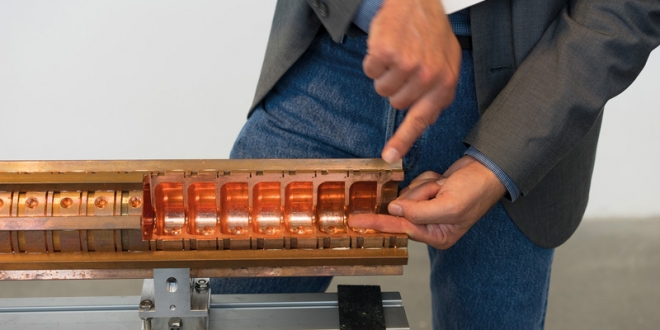“I think MAX IV is the brightest idea Sweden has had in a long while. This Laboratory will explore all of Earth’s building blocks on all the different levels”, says Christoph Quitmann, Director of MAX IV.
Long construction process
MAX IV officially opened June 21, and the laboratory is expected to be fully expanded with its approximately 30 steel pipes in 2026. In October it is time for the first external scientists to start their experiments, but the construction of MAX IV started in 2010. The total cost for the construction is estimated to land at six billion SEK and it is the University that stands as host for the building.
A political compromise
The facility has also become an important prestige project for Lund’s municipality and the placement of the laboratory out in Brunnshög is somewhat of a compromise between scientists and politicians.
The politicians wanted to build it close to the highway so that everyone who passes through Lund can see the facility. This despite that vibrations from the highway risk disturbing the experiments by affecting the light ray. To counteract these vibrations they have therefore surrounded the facility with small hills, and according to the latest readings they seem to lessen the vibrations well enough.
The light makes the invisible visible
MAX IV is going to be used much like a microscope to make what is invisible, visible. This is done by shining light on a material with a ray of light that is extremely strong, and focused to the point that the scientists can study as few as a couple of hundred atoms at a time. Which in its turn makes it possible to measure how the light bounces against the atoms, and in that way comprehend which placement they have relative to each other.
“What we wish to understand is how different atoms form molecules and how they separate”, says Christoph Quitmann.
To put it simply, you accelerate the particles (in this case the electrons). Because it is a charged particle that is being accelerated it loses energy every time it turns, and sends out the energy in the form of light. That light is what the scientists use to look at atoms and molecules, similar to a huge microscope.
A wide area of use
Christoph Quitmann describes the MAX IV laboratory as research’s answer to the Swiss army knife. At the laboratory, scientists will be able to research the world in a variety of fields and sciences. Their research will in its turn hopefully be possible to use when developing new medicines, more effective sun catchers, better batteries, highly effective catalysts and more environmentally friendly packaging.
The glory days will be short
However, the glory days of MAX IV are predicted to be short lived. For some time, it will be one of the leading facilities in the world on synchrotron light research, but it is already known that the facility will be surpassed by others.
“There are about ten ongoing projects in the world, and they all share the goal of wanting to beat us. Most of them will be finished between 2018 and 2021, but we already have ideas on how to keep the lead with MAX IV in this race”, Christoph Quitmann says.
Basic research and company research
Because the laboratory is built and sponsored mostly by Swedish tax money, it will cost if a company wishes to do experiments here and keep their results secret. But for the scientists who do research and are willing to share their results with the public, experiments will be free.
The thought is that laboratory time will be split up in equal parts between company research and other research. The ambition is to be able to perform several hundred experiments each year.
Important to include students
The facility is expected to have a lifespan of about 25 years. During these years, innumerable students from all over the world will have a chance to join and conduct experiments at the facility.
“It’s important to us that students are widely included in the experiments performed, and we hope that more parts of Lund University will be moved out to us. We constantly need new minds. This place is fully dependent on that to function”, says Pedro Fernandes Tavares, Project Manager at MAX IV.
Former students already on location
One of the new minds currently working at the facility is former physics student Robin Svärd. After five years as a student at Lund University he is now project employed as a research engineer at MAX IV.
“A regular day on the job I kick-bike hell of a lot. My responsibility is mainly to monitor the drift, but there is also programming”, says Robin Svärd.
Despite not being directly involved in any experiments today he thinks the laboratory is an exciting work place.
“MAX IV is a tool that opens up to many types of research in many different faculties. The laboratory will have a significant meaning to all faculties of natural science, as well as the industrial world”, Robin Svärd says.
He is extra enthusiastic about the basic research that will be conducted at MAX IV.
“The basic research is research for real, and it is always done out of curiosity. You have a theory you want to try and hopefully you discover something new”, says Robin Svärd.
Translation: Elise Petersson








